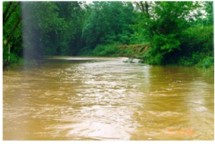| Studies of Bed Load Transport in Streams |

|
 |
Principal Investigator:Dr. Roger Kuhnle, Retired |
Problem:
Movement and deposition of sand and gravel by flowing water reduces the capability of rivers and streams to carry flood water, reduces water storage in lakes and reservoirs, pollutes surface waters, and can cause or increase bank erosion. Despite these problems it is difficult to predict the size and amount of sediment that a given flow of water will move. These problems are compounded when the material on the stream bottom consists of varying amounts of sand and gravel.
Objective:
Techniques used to predict the rate of movement of sand and gravel mixtures in field streams lack generality and cannot be relied on to yield accurate results. This research seeks to improve prediction of the rate of movement of sediment on the bottom of stream channels for a given flow rate of water. Better sediment transport predictors are needed to allow more effective management of agricultural and other watersheds.
Description of Work:
Ongoing experiments have been conducted in a laboratory channel and field stream and have concentrated on accurately measuring the flow strength and the rate of transport of sand and gravel as bed load. This combined approach of laboratory and field experiments allows concepts developed from laboratory or field experiments to be compared and tested against each other.
Benefits:
This work will lead to more accurate prediction of the movement of sand and gravel along the beds of streams. Improved sediment transport algorithms for use in watershed models will be developed. These improved models allow agricultural watersheds to be more effectively managed for the sustainable production of food and fiber in an environmentally responsible manner.
